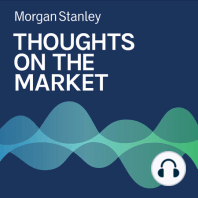4 min listen
US Economy: Bigger, But Not Tighter
ratings:
Length:
12 minutes
Released:
Apr 23, 2024
Format:
Podcast episode
Description
New data on both immigration and inflation defied predictions and may have shifted the Fed’s perspective. Our Chief U.S. Economist and Head of U.S. Rates Strategy share their updated outlooks. ----- Transcript -----Ellen Zentner: Welcome to Thoughts on the Market. I'm Ellen Zentner, Morgan Stanley's Chief US Economist.Guneet Dhingra: And I'm Guneet Dhingra, Head of US Rates Strategy.Ellen Zentner: And today on the podcast, we'll be discussing some significant changes to our US economic outlook and US rates outlook for the rest of this year.It's Tuesday, April 23rd at 10am in New York.Guneet Dhingra: So, Ellen, last week you put out an updated view on your outlook -- with some substantial forecast changes. Can you give us the headlines on GDP, inflation and the Fed forecast path? And what has really changed versus your last update?Ellen Zentner: Sure Guneet. So, our last economic outlook update was in November last year. And since that time, really, the impetus for all of these changes came from immigration. So, we got new immigration data from the CBO, and just to give you a sense of the magnitude of upward revision, we thought we had an increase of 800,000 in 2023. It turns out it was 3.3 million. And so far, the flows of immigrants suggest that we're going to get about as many as last year, if not a little bit more. And so, what does that mean? Faster population growth, those are more mouths to feed. You've got a faster labor force growth. They can work. They are working. And data historically shows that their labor force participation rates are higher than native born Americans.So, you've got to take all this into account. And it means that you've got this big positive supply side shock. And so, when the labor market has been about balance now between demand and supply, as Chair Powell's been noting, you're now going to have supply outrun demand this year.And so, you basically got much more labor market slack. You've got -- and I'm going to steal Chair Powell's words here -- you've got a bigger economy, but not a tighter economy. So, it's faster GDP growth. We have taken out one Fed cut, and I know we're going to talk about that because inflation has surprised the upside recently. But you've got slower wage growth. More labor market slack. And so, we did not change our overall inflation numbers on the back of this better growth and better labor force growth.Guneet Dhingra: That's very helpful. That's a very interesting read in the economy, Ellen. Do you think the Fed is reading the supply side story the same way as you are? And said differently, is the Fed on the same page as you? And if not, when do you think they could be?Ellen Zentner: Yeah. So, you know, Chair Powell, if you go back to his speeches and the minutes from the Fed. They've been talking about immigration. I think we've known for a while that the numbers were bigger than previously thought. But how you interpret that into an outlook can be different. And it takes some time. It even took us some time -- about a month -- to finally digest all the numbers and figure out exactly what it meant for our outlook. So, here's the biggest, I think, change for them in terms of what it means. The break-even level for payrolls is just that much higher.Now what does break even mean? It means it's the pace of job gains you need to generate each month in order to just keep the unemployment rate steady. And six months ago, we all thought it was 100, 000, including the Chair. And now we think it's 265,000. That is eye popping. And it means that when you see these big labor market numbers -- 250, 000; 300,000. That's normal. And that's not a labor market that's too tight.And so, I think the easiest thing the Fed, has realized is that they don't need to worry about the labor market. There's a lot more slack there. There's going to be a lot more slack there this year. Wage growth has come down because of it. ECI, or Employment Cost Index, is going to come down for this year. The
Released:
Apr 23, 2024
Format:
Podcast episode
Titles in the series (100)
Michael Zezas: Indirect Impacts by Thoughts on the Market
